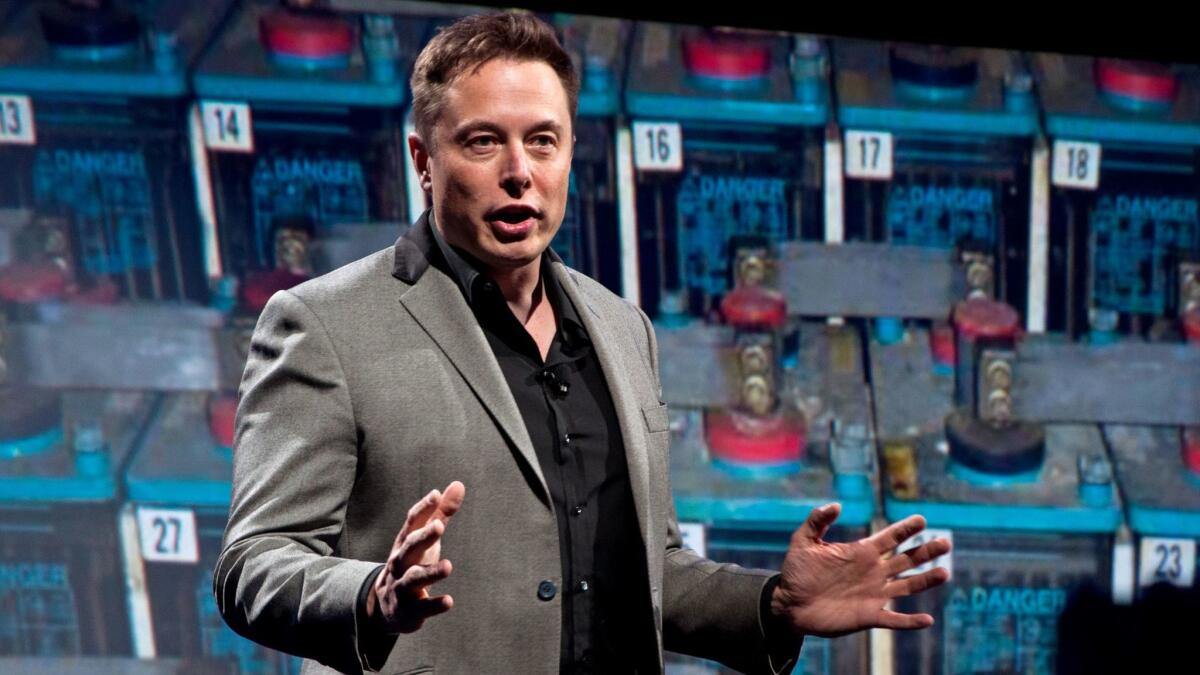Why Elon Musk is pitching solar panels to Puerto Rico even as residents lack clean water

- Share via
Elon Musk has big dreams for Puerto Rico. On Thursday, the Tesla Inc. chief executive said he would discuss building a high-tech solar grid for the island with Ricardo Rossello, Puerto Rico’s governor.
“Let’s talk,” Rossello tweeted at Musk.
“I would be happy to talk,” Musk replied. “Hopefully, Tesla can be helpful.”
Although Musk’s idea doesn’t solve Puerto Rico’s current crisis — 90% of the island is still without power, and many are having trouble getting clean water — it could set the island on the path to sustainable, renewable energy, which could reduce its dependence on imported fossil fuels and ultimately bolster its economy. The proposal, in other words, makes a great deal of sense, even if it doesn’t help right away.
Puerto Rico’s electric company already was in shambles. In July, it basically filed for bankruptcy, saying it owed $9 billion and needed an additional $4 billion to revamp its power plants, whose median age is 40 years old.
That was before Hurricane Maria struck. Now, in light of the damage to Puerto Rico’s electric grid, people such as Musk are seeing the crisis as a chance for the island to move away from centralized, vulnerable electricity systems.
“The Tesla team has done this for many smaller islands around the world, but there is no scalability limit, so it can be done for Puerto Rico too. Such a decision would be in the hands of the PR govt, PUC, any commercial stakeholders and, most importantly, the people of PR,” Musk posted Thursday on Twitter.
Among the “many smaller islands” to which Musk is referring is the island of Ta’u in American Samoa. Last year, Tesla said it had wired Ta’u with thousands of solar panels and batteries that would meet nearly all of the energy needs of its 600 residents. It was an example of how, under the right conditions, an island population could shift almost entirely away from fossil fuels.
According to Musk, there’s no reason something similar couldn’t be achieved in Puerto Rico.
Musk isn’t exactly going out on a limb here. Scientists and energy experts say that a distributed grid that doesn’t rely on a single power plant for energy generation could help vulnerable island regions such as the Caribbean weather strong storms like Irma or Maria.
Solar panels, which can feed their power into batteries and be linked together into local or regional power grids, are one example of a technology that could spread the potential risk out across a population. And at tropical latitudes, you get the most bang for your solar buck: Photovoltaic panels located there are even more effective at energy generation than they are at higher latitudes.
The long-term economic benefits could be equally transformative. Island residents face some of the highest energy prices in the world because the vast majority of their fuel must be imported. Reducing those fuel costs by switching to wind or solar could permanently set these island economies on a more positive trajectory.
“When we are facing the sort of infrastructure destruction we have seen this hurricane season, it only makes sense to give some pause before reinvesting in the exact same system that proved too vulnerable,” Gwen Holdmann, who directs the Alaska Center for Energy and Power at the University of Alaska in Fairbanks, said in an email.
“If [Puerto Rico’s] system were redesigned around microgrids incorporating local power production,” Holdmann said, “there would still be losses, but the number and duration of outages due to severe weather events would decrease.”
So it’s really no surprise to see solar advocates such as Musk reaching out to Puerto Rico.
Fung writes for the Washington Post.
More to Read
Inside the business of entertainment
The Wide Shot brings you news, analysis and insights on everything from streaming wars to production — and what it all means for the future.
You may occasionally receive promotional content from the Los Angeles Times.










